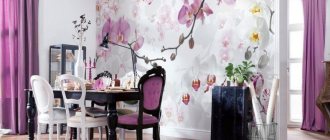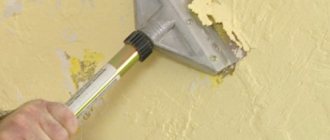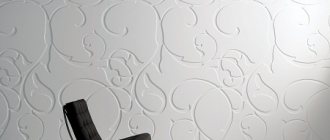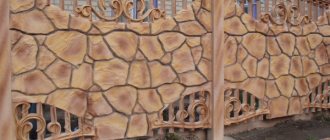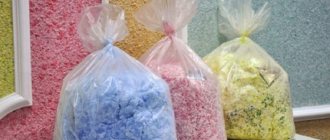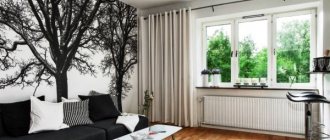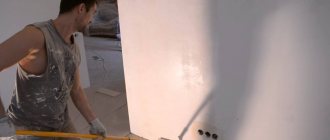Which canvases can be painted?
Nowadays, the market surprises with a wide range of materials for wall decoration. The design and color of canvases have long been no longer considered a determining factor, because each buyer can choose an original pattern by simply adding the selected pigment to the paint. Thus, painting wallpaper becomes the most affordable and easiest method of changing the interior with your own hands.
Painting wallpaper is an affordable way to change the interior yourself
However, this finish has its limitations - more layers of paint cannot be applied to it than specified by the manufacturer. Glass wallpaper is considered the most durable and reliable - coloring compounds can be applied to such wallpaper for painting more than 15 times, and to canvases with a convex relief and large pattern - more than 20 times.
Paper wallpaper can be painted no more than 3 times. Subsequent applications have a bad effect on the structure of the finish, resulting in the formation of holes in it.
Often, beginners try to paint thick vinyl-based wallpaper, which is glued to the wall using PVA glue. But experienced craftsmen do not advise making such attempts, except perhaps for painting over children's drawings on canvas.
Wallpaper on which a coloring composition can be applied has a more noble appearance. Among the main textures, the following canvases stand out:
- smooth;
- with small patterns;
- with large ornaments;
- wallpaper with different relief.
Depending on the type of base and its technical characteristics, wall panels are divided into:
- glass wallpaper;
- non-woven;
- vinyl;
- impregnated paper;
- linkrusta wallpaper - their relief is created by applying a special composition of chalk, flour, tree bark and wax.
Properly painted wallpaper can last for a very long time.
If you paint roll wallpaper correctly, then such canvases can last from 10 to 15 years. In this case, the first tone should be made as light as possible so that after applying the paint the base does not begin to show through. Further layers of paint should be a shade darker than the base.
Unlike ordinary wallpaper, canvases that are coated with paint can be washed. Thanks to the protective layer, they will not come apart from moisture. This makes it possible to use this finish for decorating children's rooms, where the risk of staining the material is especially high.
How to apply the first layer
In the painting process, the most difficult moment for beginners who will do this with their own hands is applying the primary layer. The final result and the final appearance of the walls or ceiling depend on how well the first layer is applied.
But before considering the features of applying water-based paint yourself, it should be noted that the base for the paint must be special. The following paintable wallpapers are suitable for these purposes:
- vinyl;
- non-woven;
- glass wallpaper.
Some people wonder “is it possible to paint liquid wallpaper?” This question arose from the specificity that liquid wallpaper has. Once applied to the surface, liquid wallpaper allows you to create a layer of finish that is pleasant to the touch. But it will be lost if the liquid wallpaper is painted. Therefore, if you decide to paint liquid wallpaper, weigh the pros and cons. Experts recommend using the above-mentioned materials rather than liquid wallpaper as a base for paint.
Typically, paint is applied to a base such as wallpaper (special or liquid) in several layers. The main thing here is to apply the first layer correctly, and the rest will go on without problems. The technology of applying paint in several layers allows you to obtain certain patterns and designs on the ceiling or walls. Moreover, if you master this technology correctly, you can achieve an unusual result, even without being an artist.
To apply the first coat of paint, special preparation must be carried out. It involves sealing all places that should not be touched by paint with special masking tape. In addition, the entire work surface on the ceiling or walls must be cleaned of dust and dirt. For these purposes, use a damp cloth.
Related article: How to remove paint from a bathroom wall with your own hands
Also, before painting, you need to purchase water-based paint with pigment. It is necessary to calculate the consumption of coloring material per 1 m2 of surface. This is necessary in order to immediately prepare the required volume of the mixture and so that it has the same color. This is the only way to achieve a uniform shade over the entire surface of the ceiling and walls.
After the preparation has been completed, you can begin to apply the primary layer yourself. In this situation, the algorithm of actions taken is as follows:
- First, a little dye should be applied to a section of the wall or ceiling. This area should be the least noticeable. This way you can visually evaluate the final result and the correctness of the selected proportions used to prepare the dye.
- If you are satisfied with the result, painting the remaining areas on the ceiling or walls should be done using a soft roller.
- The first layer is applied in one direction, and all subsequent layers in another.
After this, when the first thin layer of paint has been applied to the prepared surface, it must be given time to dry completely.
Remember that after painting walls or ceilings with water-based paint, it will be quite problematic to stick wallpaper on them. Therefore, if you are planning an application, the place where it will be applied must be covered with masking tape before painting.
How to correctly calculate the required amount of paint?
To ensure you have enough paint, you must calculate the required amount of composition. To do this, take into account factors such as the total area of the pasted surface, the consumption of the coloring composition per 1 m2 and the absorbent properties of the canvas.
The paint can usually indicates the approximate consumption per square meter
The total area includes the area of all walls and ceiling, if you plan to paint that too. From these indicators, subtract the area of the windows and add approximately 200–300 g of paint in reserve. As a result, you will get the total working surface area.
The approximate paint consumption per square meter is indicated by the manufacturer on the can with the composition. Please note that each manufacturer’s paint differs in absorption properties and density, so it will be used differently. The “standard” consumption is about 200 g/m2. If the paint is applied in 2 layers, then this figure will increase to 250 g/m2. It is also important to take into account the ability of the canvas to absorb paint. Thus, wallpaper made of paper and non-woven material absorbs much more composition than fiberglass materials.
Buying paint - how to choose the right composition for the job?
To paint wallpaper well, when choosing paint, pay attention to factors such as the material of the canvas and the function of the room in the house. Each type of base requires a specific type of paint.
Paper wallpaper can only be painted with water-based paint. For non-woven fabrics, compositions based on water-dispersed components are suitable, and for glass wallpaper, latex or acrylic paint is used. Experts advise applying acrylic, wax or oil-based liquid paste to linkrust wallpaper.
Be sure to consider the type of room. So, acrylic paint is suitable for washable surfaces in the bathroom or kitchen. The surface painted with them is very easy to clean, as a protective film is formed on it. Fabrics on which such compositions are applied will pass and absorb air worse, but they are not afraid of the effects of steam.
In open, brightly lit rooms, latex compounds are used. They do not fade when exposed to UV rays, but they must be handled with extreme care when cleaning. Wallpaper after painting with latex compounds cannot be washed; only dry cleaning is allowed.
When choosing paint, you also need to take into account the degree of light reflection of the coloring composition. Depending on this, experts distinguish between matte, satin, glossy and semi-matte paint.
Satin paints with a moderate sheen are ideal for the bathroom or kitchen. They are characterized by high durability and reliability. Matte compositions perfectly hide defects in walls and ceilings. They also handle excess light well. Glossy paints, on the contrary, visually increase lighting. Experts often paint embossed wallpaper with matte paint to achieve a jacquard effect.
Experts advise beginners to paint wallpaper with water-based paint - it is easy to apply and the most durable. Acrylic compositions are considered the most versatile in use.
To ensure that the painted wallpaper looks exactly the way you plan, test the color intensity of the composition on a control sample before work. If the shade turns out to be too pale, then pigment will need to be added to the composition. Make sure that the amount of pigment in each can of paint is the same.
To prevent the paint from drying out, open the can immediately before work.
The algorithm for the work ahead is quite simple. The ceiling should be painted first, followed by the exposed wallpapered walls, and finally the secondary walls behind the cabinets and sofas. In order not to stain the floor and interior items, they need to be covered with old newspapers.
Painting compounds in open cans dry out fairly quickly. Therefore, you need to open and dilute the paint immediately before applying it.
Selecting a roller and other necessary tools
Before painting the wallpaper, you need to prepare the necessary tools. First of all, you will need a paint roller - with it the work will go quickly and without problems. However, stores have a wide selection of different tools, and without knowing which one is suitable for painting a canvas, beginners make a lot of mistakes. For example, you can find rollers on sale:
- with long pile;
- with short hairs;
- velor roller;
- fur roller;
- foam tool.
To paint wallpaper you will need a roller.
Each of the tools is designed for specific cases. So, with a short-haired roller you can easily roll out a relief image, while a long-haired tool will help to deeply paint the entire texture. A foam tool leaves unpainted bubbles if it touches smooth walls. You can also find tools with replaceable attachments on sale. When working with them, specialists carefully check and rinse them and only then cover the canvas with paint.
To paint wallpaper for further painting without streaks, experts advise buying a roller with short pile. It will absorb the right amount of paint and distribute it evenly over the surface.
For painting corners and hard-to-reach places, buy a couple of paint brushes. You need to dip the roller into a special cuvette. To stir the composition with the solvent you will need a bucket.
What can you paint?
The answer to the question whether it is possible to paint and repaint wallpaper depends on what exactly the walls are covered with. You can change the color of the walls in this way if on them:
- paper;
- interlining;
- silk plaster.
Important! There are special wallpapers that can be painted – there are no problems with them, that’s what they are designed for. Non-woven fabric can be painted beautifully, and you can paint both the wallpaper itself and the wall underneath it. Silk plaster can be removed, and with the help of another dye and various additives, a new color and texture can be obtained, and then the walls can be covered with it again. Many people like this repainting.
There are coatings that do not make sense to paint in the usual way:
- textile panels;
- glass wallpaper.
In these cases, other technologies are used.
Important! As for vinyl-based coatings, painting them is more difficult than gluing them. The easiest way is to apply paint to paper.
Subtleties of painting finishes depending on its type
Painting non-woven wallpaper is an excellent opportunity to get an original design. After work, the surface will imitate more expensive exclusive finishing materials. Also, such canvases look good on the wall even without painting, thanks to the embossed outer side.
If you will frequently clean the canvas made of this material, then use latex paint for painting, which gives the finish a protective layer. To work with such materials, a fur roller and a brush for hard-to-reach places are suitable. This wallpaper is painted in at least two layers. When applying, do not keep the roller in one place for a long time, otherwise it will lead to drips.
Non-woven wallpaper must be painted in at least two layers
Paper wallpaper must be properly prepared before painting. To do this, the canvas is coated with a special impregnation that prevents the paint from flowing over a smooth surface. It is optimal to apply one layer. However, if you made mistakes when applying it, the canvas can be covered with another layer. Before painting, make sure that there are no traces of glue on the seams of the trim, otherwise it will significantly complicate the work.
Glass wallpaper is considered the most durable material for painting. They are made from fiberglass. The most popular textures among buyers are considered to be “path”, “herringbone” and “cobweb”. They are ideal for repeated application of paint, which penetrates deeply between the fibers of the fabric. Before painting, glass wallpaper will need to be primed. After this, a latex or acrylic composition is applied to the material. This wallpaper is painted in two layers.
Vinyl sheets on a paper backing provide a multi-layered paper texture. Before painting, the canvas made of this material also needs to be primed. After the primer has dried, you need to apply the coloring composition. To do this, use a long-haired roller and a paint brush. Once the paint has dried a little, apply it a second time. Lastly, a decorative layer is applied, but if the canvas is not embossed, then you can do without it.
Painting and finishing of the canvas
After applying and drying the primer layer, proceed directly to painting the canvas. To do this, pour a third of the paint can into a bucket and add solvent. Mix the ingredients thoroughly and pour the mixture into the cuvette. Wet the roller and start painting. It is best to apply paint to the walls starting from the top and gradually moving down.
Be sure to ensure that after application there are no drips or unpainted areas.
The paint is mixed with solvent in a ditch.
As soon as the first layer is completely dry, begin applying the second layer. After painting large areas, begin applying the compound in hard-to-reach areas. To do this, lower the brush into the paint tray and start painting in the upper corner of the room. When painting, make sure that no lint remains on the wall after brushing.
After the second layer has completely dried, you can begin to decorate the canvas with a decorative layer. Before doing this, we advise you to make a rough drawing of your patterns and follow it. Try to put maximum imagination and creativity into your image to make the interior of your room original.
After the third layer has dried, you can also coat the finish with clear varnish. This will be especially relevant when decorating children's rooms, where it is unlikely that mechanical damage to the finish will be avoided.
Drawings and decoration
After the first layer of paint has dried, you can begin to decorate the ceiling or walls by creating certain applications, ornaments and designs on their surface.
This stage should be planned before the renovation and purchase of wallpaper begins. Indeed, today such finishing has a wide range of products, differing in texture, patterns and other characteristics.
When creating drawings with other types of paint, you can use a hard roller and wallpaper with a pronounced relief. Thus, you can paint your wallpaper with your own hands with water-based paint of a different color and get a beautiful and unusual design. In addition, to obtain certain artistic effects, you can use the following tools:
- brushes of different sizes;
- stencils;
- cotton swabs.
Related article: Rules and nuances of installing roof rails in the kitchen
Thanks to such tools, a person will be able to create even a complex floral ornament with his own hands.
Decor and designs are applied with dyes of other colors that contrast with the primary layer. It is desirable that the dye chosen in this situation has certain properties (for example, moisture resistance, mechanical resistance, etc.). For these purposes, there are a wide variety of special artistic compositions. But their cost is quite high. Therefore, they are usually used by professionals who have the necessary skills and knowledge.
If the paint does not have additional properties, after it has dried, the surface of the walls and ceiling can be varnished for a longer service life.
The key to successfully applying decor with water-based paint is correctly selected materials with compatible components. Using such materials, even a beginner can achieve excellent results and high quality of work done with their own hands.
Secrets of proper painting - what experts recommend
To avoid problems when painting canvas, we suggest that you familiarize yourself with expert advice that will greatly facilitate the work of novice repairmen. When preparing a room for painting, experts advise covering not only the floor and furniture, but also windows, sockets and baseboards from paint. After preparation, wet the roller in the paint pan. After this, be sure to roll it on an old newspaper so that drips do not appear when painting the walls.
The color of the wallpaper to be painted also plays a huge role. It is best to choose canvases of a white or light shade. To apply the composition more evenly, experts advise using a spray gun instead of a roller.
If you just can’t get rid of pieces of old wallpaper, then you can hide their traces and imperfections on the walls by applying matte paint to the new finish.
Preparation of materials and surface
Some experts at the preparation stage advise applying a primer to the canvas to ensure better distribution of paint over the finishing surface and prevent the formation of stains. Typically, paint stains appear due to uneven saturation of the finishing surface. But in this situation, when using special wallpaper and water-based paint, the use of a primer is not a prerequisite. In addition, the finish itself already has high adhesion, which does not need to be increased further.
Related article: Sliding doors to the balcony: selection and installation
You also need to carry out the following manipulations:
- de-energize the room to prevent short circuits and accidents;
- the temperature regime of the room must meet the requirements of the dye application technology;
- close all windows and doors to prevent the risk of drafts (this will ensure even drying of painted surfaces);
- cover the floor, doors and windows with covering material.
In addition, you will need the following materials:
- different types of rollers for applying the primary layer and patterns;
- tassels;
- tray;
- masking tape;
- ladder.
It would be a good idea to use protective clothing (gloves, hats, goggles) while working.
